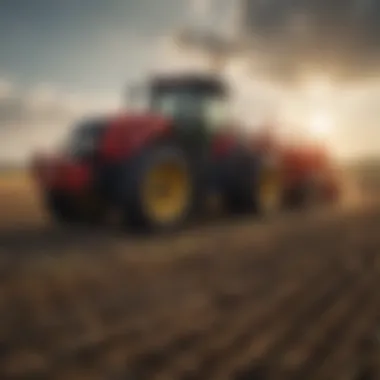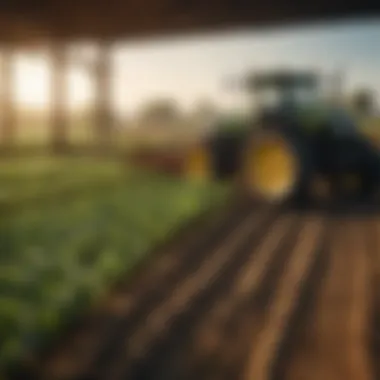Transforming Crop Farming with Precision Agriculture


Intro
Precision agriculture technology is no longer a novel concept; rather, it has evolved into a critical facet of modern cro farming. This approach harnesses data and technology to optimize every step in the agricultural process, from planting to harvesting. Farmers are increasingly turning to tools such as GPS-guided equipment, drones, and soil sensors to drive efficiency and enhance yields. By utilizing these technologies, the farming community is on the brink of a paradigm shift that promises to reshape the landscape of agriculture.
As we navigate through this exploration of precision agriculture, it is vital to understand not just the mechanics behind it but also the profound impacts it has on sustainability and productivity. The article will highlight key trends shaping the industry, explore sustainable practices that can be adopted and provide actionable gardening techniques and tips.
Each section aims to yield insights that resonate with farmers and agricultural enthusiasts alike, making this compendium a valuable resource.
Latest Trends in Agriculture
Overview of Current Trends
Recent years have seen a surge in the adoption of precision agriculture technologies. Farmers are turning to smart tractors equipped with satellite navigation to reduce overlap during tasks like planting and spraying. Drones are also playing a significant role, offering aerial views that help assess crop health and monitor field conditions swiftly. This accessibility to high-resolution imagery and real-time data is helping farmers make well-informed decisions.
Moreover, the trend towards data-driven agriculture is undeniable. Precision soil maps, generated from advanced sensors, allow farmers to tailor their nutrient application, optimizing resource use. It's not only good for the wallet but also beneficial to the environment, minimizing unnecessary chemical use.
Impact of Technology on Farming Practices
Technology is changing the way farming is approached. With the introduction of integrated systems that bring together equipment, software, and agronomic data, farmers are better positioned to monitor and manage every aspect of their fields. For example, a system that merges weather forecasts with soil moisture readings can inform irrigation schedules, promoting water conservation.
"The future of agriculture hinges on integrating technology with farming practices to cultivate smarter, more productive crops."
Implementing such technologies may appear daunting initially, especially for traditional farmers. However, those who adapt swiftly are often the ones reaping the greatest benefits, standing at the forefront of a revolution that’s not just statistical but also deeply ecological.
Sustainable Practices: Towards a Greener Future
Importance of Sustainability in Agriculture
Sustainability has become a pressing theme in agriculture. With the world's population rapidly growing, the demand for food is escalating. Farmers must navigate this landscape while safeguarding natural resources. By embracing sustainable practices, farmers can contribute to a healthier planet and ensure food security.
Emphasizing sustainability means acknowledging and acting on the interconnectedness of ecosystems. Soil health, biodiversity, and resource management are inseparable elements that demand attention and strategic planning. Farmers who prioritize sustainability foster resilience, not only in their crops but also in their farming operations.
Methods for Sustainable Farming
Implementing sustainable methods in farming entails several strategies:
- Crop Rotation: Alternating crops helps maintain soil integrity and reduces pest build-up.
- No-Till Farming: This practice minimizes soil disturbance, preserving its structure and moisture content.
- Integrated Pest Management (IPM): Utilizing natural predators and diverse planting reduces reliance on chemical pesticides.
- Cover Cropping: Planting cover crops during off-seasons aids in erosion control and enhances soil nutrients.
These methods not only enrich the land but can also lead to economic advantages by diminishing input costs over time.
Gardening Techniques and Tips
Essential Gardening Tools and Equipment
In the context of both professional and backyard farming, having the right tools cannot be stressed enough. Essential equipment includes:
- Trowel: For digging and moving soil.
- Pruning Shears: For managing plant growth and removing dead branches.
- Soil Moisture Meter: To measure moisture levels in the soil, ensuring optimal watering practices.
- High-Quality Seeds: The foundation of successful gardening lies in selecting the right seeds suited for your climate.
Seasonal Gardening Practices
Gardening varies with the seasons, and recognizing when to plant and harvest is pivotal. Here are some seasonal considerations:
- Spring: Focus on planting vegetables like tomatoes and peppers after the frost.
- Summer: Ensure adequate watering and mulch to retain soil moisture.
- Fall: Time to harvest and consider planting cover crops to enrich the soil during winter.
- Winter: Plan for the upcoming season, tending to indoor plants and ordering seeds.


Understanding Precision Agriculture
The world of agriculture is on the cusp of a transformation that promises to redefine how we cultivate crops. With the advent of precision agriculture, farmers are looking beyond traditional methods to embrace technologies that offer measurable improvements in yields and sustainability. Understanding this shift is crucial for anyone involved in farming, as it encompasses a broad spectrum of concepts that can significantly affect productivity and efficiency.
Definition and Concepts
At its core, precision agriculture refers to the innovative use of technology and data analytics to manage farming practices variably, rather than uniformly. This means that decisions regarding sowing, irrigation, and fertilization are made based on specific data about the land, crops, and environmental conditions rather than a one-size-fits-all approach. Key elements include:
- Data Collection: Gathering information from various sources like soil sensors, weather stations, and crop health monitors.
- Data Analysis: Interpreting the collected data to make informed decisions.
- Variable Rate Technology: Applying resources such as water and fertilizers in a way that varies by section of the field based on the data.
This tailored approach leads to the efficient use of resources, reducing waste and minimizing environmental impacts.
Historical Context of Farming Practices
Historically, farming has relied heavily on trial and error along with anecdotal practices passed down through generations. For decades, farmers depended on broad-spectrum fertilizers and uniform planting techniques. However, as farming practices evolved, there came a realization that each piece of land has unique characteristics that respond differently to cultivation methods.
In the mid-20th century, advances in agronomy began to pave the way for more precise methods, but it wasn’t until the late 1990s that technology like GPS and satellite imagery brought about a revolution. Farms began to employ precision tools, which were especially beneficial for large-scale operations. Factory farming faced new challenges—more crops meant more cumbersome management processes, thus the need for precision couldn't be ignored. As a result, farming gradually shifted towards practices that are backed by scientific methodologies, leading us to the modern era of precision agriculture.
The Shift Towards Data-Driven Agriculture
In the past, many farming decisions were based on hypothesis. Fertilizing largely came down to general recommendations without considering soil-specific conditions. However, the growing availability of data-centric tools is steering farmers right toward their fields' unique requirements. Here's how:
- Empowering Farmers: With smartphones and tablets, farmers can access real-time data and make on-the-spot decisions, shifting the control back to the landowners.
- Maximizing Input Efficiency: The integration of sensors allows farmers to see how certain crops respond to varying input rates throughout the season. This not only saves money but also reduces environmental impact.
- Predictive Analytics: By analyzing past and present data, farmers can make forecasts that help anticipate crop diseases, pest issues, or even market changes.
- Improved Sustainability: Through data-driven decisions, farmers can implement sustainable practices that not only benefit their yield but also preserve the environment for future generations.
The analytical approach of precision agriculture is transforming decisions from the intuitive to the informed, optimizing crop productivity while fostering sustainability.
In concluding this discussion on understanding precision agriculture, it's evident that the implications of harnessing technology within this domain are profound. From optimizing resource usage to enhancing decision-making processes, the move towards a more data-inspired farming landscape signifies a commitment not only to improving crop yields but also to ensuring that agriculture remains viable in an increasingly complex world.
Core Technologies in Precision Agriculture
In today’s agricultural realm, core technologies represent the backbone of precision agriculture, shaping the way crops are managed and nurtured. These technologies are not merely tools; they embody a fundamental shift towards data-driven practices that enhance decision-making, improve efficiency, and promote sustainability in farming. The integration of these technologies allows farmers to make informed choices based on real-time data, drastically altering traditional methods of cultivation. Engaging with these tools implies not just surviving but thriving in an ever-demanding agricultural environment.
Geospatial Mapping Techniques
Geospatial mapping techniques have opened a new frontier in how farmers observe and respond to their fields. This technology harnesses satellite imagery and advanced software to create detailed maps of farmland. These maps can reveal variations in soil types, moisture levels, and even crop health across different areas of the field. It’s akin to having a treasure map that pinpoints areas of potential harvest abundance.
Farmers can also apply these maps for precision planting. By understanding the unique needs of each segment of their land, they can plant crops in a manner that maximizes the potential of each area. This targeted approach draws a direct line between the proper use of land and increased yields, making it clear that a one-size-fits-all method is a relic of the past.
Remote Sensing Technologies
When it comes to remote sensing, think of it as giving your crops the gift of sight. This technology involves collecting data from the atmosphere to gauge the health and status of plants. Sensors mounted on satellites or aircraft can detect changes in plant coloration, temperature, and moisture content, often before the farmer can even notice them by eye. The data gleaned from these observations allow farmers to act proactively instead of reactively—much like having a crystal ball that forecasts issues such as pest infestations or nutrient deficiencies before they spiral out of control.
Additionally, remote sensing promotes greater efficiency in resource allocation. With the insights gained, farmers can apply fertilizers or pesticides only where they’re truly needed, minimizing waste and reducing overall inputs.
Global Positioning Systems (GPS)
Global Positioning Systems (GPS) might be most commonly associated with navigation, but, in agriculture, it serves a far greater purpose. GPS technology enables precise location tracking in the field, allowing for accurate planting, harvesting, and application of inputs. Farmers can delineate exact boundaries, ensuring that every inch of their land is utilized correctly.
The capabilities extend to autonomous machinery as well, with tractors and harvesters equipped with GPS technology being able to drive themselves. Such automation increases efficiency and reduces labor costs. In an age where every minute counts, GPS stands as a vital tool in minimizing operational delays and maximizing productivity.
Drones in Agriculture
Drones, once thought to be only for aerial photography, have swiftly become a farmer’s best friend. Equipped with high-resolution cameras and sensors, they provide an aerial view of the land, offering data that is often impossible to gather from the ground. Farmers can conduct aerial surveys to monitor crop health, irrigation systems, and soil conditions, making it easier to spot any troublesome spots.


The use of drones cuts down on the time taken for field assessments and enables quicker response times to any issues that may emerge. Furthermore, drones help optimize pesticide application, ensuring that the right amount is applied precisely where it's needed, which ultimately promotes healthier crops with fewer chemicals.
IoT Devices and Sensors
Integrating the Internet of Things (IoT) devices into agriculture transforms how data is captured and utilized. Sensors placed in the fields relay real-time information regarding soil moisture, temperature, and crop conditions directly to the farmer’s devices. It’s like having a constant check-up on your crops’ health without the inconvenience of manual monitoring.
Farmers benefit from the fine-tuning of irrigation systems made possible through these sensors. Rather than following a traditional schedule, irrigation can be conducted on an as-needed basis, preserving precious water resources and ensuring optimum growth conditions.
By employing these core technologies, farmers stand at the forefront of innovation that not only enhances productivity and profitability but also fosters a sustainable approach to farming. The landscape of agriculture is changing, and those who adapt and harness these tools will pave the way for future farming practices.
Benefits of Precision Agriculture
As the agricultural landscape evolves, precision agriculture technology takes center stage, bringing numerous advantages to modern farming. The ability to accurately assess crop conditions, predict outcomes, and implement targeted actions is transformative for farmers. The adoption of these technologies not only drives productivity but also opens avenues for sustainability and smarter farming practices. With pressures mounting from climate change, resource scarcity, and changing consumer demands, understanding the benefits of precision agriculture becomes crucial for stakeholders looking to enhance their farming operations.
Improved Crop Yields
Precision agriculture significantly boosts crop yields, an essential factor when aiming for food security. Utilizing data analytics, farmers can monitor variations in soil health, moisture levels, and pest pressure with stunning accuracy. For instance, a farmer might employ data from soil sensors to pinpoint nutrient deficiencies in specific areas of a field, allowing them to apply fertilizers only where needed. This targeted approach can increase overall yield without unnecessary resource use.
Additionally, through technologies such as variable rate technology, farmers can apply seeds, fertilizers, and pesticides at optimized rates tailored to unique field conditions. This minimizes waste, ensuring that every seed sown and every gallon of water used contributes to enhancing overall crop performance. Are record harvests merely a thing of folklore? Not anymore.
Efficient Resource Management
The beauty of precision agriculture lies in its capacity for efficient resource management. By leveraging data from multiple sources, farmers can fine-tune inputs to save both money and resources. For example, smart irrigation systems can automatically adjust water flow based on real-time weather forecasts and soil moisture levels, drastically reducing water wastage.
Furthermore, technologies like IoT sensors help in tracking the need for crop inputs. Instead of blanket applications, farmers can use information from these devices to understand the exact quantity and timing required for irrigation or fertilization. Efficient resource management not only strengthens a farm's bottom line but also contributes to greater sustainability, an increasingly important factor in today’s agricultural practices.
Minimizing Environmental Impact
With greater precision comes the opportunity to minimize environmental impact. Farmers can achieve a more sustainable agricultural model by reducing chemical runoff into waterways and minimizing the use of pesticides and fertilizers. For instance, applying integrated pest management algorithms helps in determining the right moment for pest intervention, hence supporting beneficial insects and promoting biodiversity.
The proactive use of technology also allows farmers to assess and adapt their practices concerning local ecosystems. When farmers know exactly where to plant and what to treat, the overall carbon footprint of farming can see significant reductions. Conservation measures become far more attainable when technology supports farmer decision-making.
"Agriculture is not just about growing crops but about nurturing the environment. Precision agriculture provides a way for farmers to achieve both."
Enhanced Decision-Making Processes
Finalizing decisions in farming can often feel like walking a tightrope. But precision agriculture paves the way for informed decision-making, essential in a field where the stakes are continuously rising. Sophisticated analytics tools synthesize vast amounts of data and present it in a digestible format, which aids farmers in making timely decisions.
For example, by utilizing predictive analytics, a farmer can forecast crop yields based on historical data and current weather patterns. This insight not only helps in market planning but also allows for strategic actions like cropping rotation. Making smarter decisions results in better crops, increased profitability, and less anxiety when it comes to unforeseen challenges in the farming process.
Challenges in Implementing Precision Agriculture
Implementing precision agriculture is not all sunshine and rainbows. While the potential benefits can skyrocket efficiency and yield, several formidable hurdles exist that farmers and agribusiness face. Understanding these challenges is vital, as they can dictate the success of agricultural endeavors.
Adapting to this precision farming approach calls for a broad look at how technology interplays with traditional methods. Here are some key challenges that can arise in the path toward effective implementation:
High Initial Costs of Technology
One of the biggest roadblocks is the staggering initial expense tied to adopting precision agriculture technology. From advanced machinery outfitted with sensors to sophisticated software systems, the price tag can be quite hefty. Many farmers, particularly those with smaller operations, may find it daunting to take the plunge. Financing options and government assistance programs can help alleviate these costs but not all farmers are aware of these resources.
"Investing in precision agriculture may seem like throwing money down a well, but the returns often justify the cost over time."
Data Management Concerns


With the integration of technology comes a deluge of data. Managing this information efficiently can be like trying to herd cats. Data overload may lead to confusion or misinterpretation, which is the last thing any farmer needs when making decisions that can impact crop health and yield. Many farmers struggle with the technical issues of storing, analyzing, and deriving actionable insights from this data. Therefore, setting up effective data management systems is crucial.
Technical Skill Gaps
A significant skill gap presents yet another challenge. Many existing farm operators may not have honed the technical skills necessary for utilizing modern agricultural technologies. Training is necessary but can be time-consuming and costly, making it less appealing to farmers who are already stretched thin. As technology advances, ongoing education becomes essential to keep pace with the rapid changes and innovations in precision agriculture.
Integration with Existing Systems
Lastly, how do you mesh the new technology with what’s already in place? Integrating precision agriculture tools with existing systems can be a stumbling block for many farms. Each farming operation likely employs a unique combination of machinery, software, and processes, creating complications when trying to embed new systems into the fold. Without finding the right synergy, the benefits of precision agriculture may remain just out of reach, leading to frustration and halting progress.
Future Trends in Precision Agriculture
As we stand at the crossroads of technology and tradition, the future of precision agriculture beckons with promise and potential. Understanding these trends is crucial for stakeholders—be it farmers on the ground, tech developers, or agronomists. They not only highlight where agriculture is heading but also underscore how innovation can align with sustainable practices and better yield outcomes. Below are some pivotal areas that are paving the way forward.
Advancements in Artificial Intelligence
Artificial Intelligence is the brain behind many cutting-edge agricultural technologies. From predicting weather patterns to optimizing planting schedules, AI’s influence is far-reaching. For instance, using machine learning algorithms, farmers can analyze historical data and real-time conditions to forecast crop yields. This capability enables proactive decision-making, allowing farmers to adjust strategies based on what the data suggests.
Moreover, AI robotics offers the potential for automation in tedious, manual tasks—be it planting seeds or harvesting crops. Such technology improves efficiency, reduces labor costs, and minimizes human error. The trend is shifting towards smart systems that can adaptively learn and even recommend practices, making farming more like navigating an intelligent system than simply following a rulebook.
Sustainable Farming Practices Using Technology
Sustainability is increasingly paramount in agriculture, and technology is central to this drive. By harnessing precision agriculture, farmers can implement practices that maximize yield while preserving the environment.
- Data Analytics: Sophisticated algorithms can analyze soil health, moisture levels, and nutrient requirements, ensuring that every input is tailored to current needs and preventing wastage.
- Precision Irrigation: Technologies like drip irrigation and moisture sensors allow farmers to apply just the right amount of water, helping conserve this vital resource.
- Regenerative Agriculture: Techniques like cover cropping and crop rotation, enhanced by tech insights, can help restore soil health over time.
Incorporating these sustainable practices not only improves efficiency but can also shield farmers from the impacts of climate change, creating resilient agricultural systems.
Collaborative Approaches and Smart Farming
The agriculture industry is shifting towards collaboration, with knowledge-sharing at its core. Farmers, tech innovators, and agricultural experts are increasingly forming alliances to address common challenges. Community-based platforms can facilitate these partnerships, where farmers can exchange data, advice, and best practices. This collaboration fosters a culture of learning and improvement, essential for tackling issues such as pest management or soil degradation effectively.
Smart farming is not just about individual farms adopting tech but about creating ecosystems. The use of connected devices enables different farms to interact, share insights, and maximize resource usage across larger geographic areas. Leveraging these relationships can optimize yield and bolster resilience against climate shifts, market changes, and other external factors.
Regulatory Framework and Support Systems
The progression of precision agriculture also hinges on a supportive regulatory framework. Policymaking can either propel or hinder the adoption of these technologies. Effective regulations should promote innovation while ensuring safety and fairness in the market. This involves creating guidelines related to data privacy, technology deployment, and sustainable practices.
Additionally, governments can intervene by offering subsidies or financial support to farmers looking to invest in precision agriculture tools. Resource allocation in research and development is equally important.
A strong support system encompasses education and capacity-building programs tailored for farmers to help them navigate the tech landscape. By equipping farmers with the necessary tools and knowledge, we can build an agricultural framework where both innovation and tradition coexist, leading to enhanced productivity and sustainability.
*"Technological advances must be combined with practical knowledge, ensuring that farmers can harness innovations successfully."*
In summary, as the agricultural community embraces these trends, the landscape will evolve into one that is more efficient and sustainable. The integration of AI, collaborative partnerships, sustainable practices, and supportive policies will pave the way for a resilient future in farming.
End: The Path Forward
The journey through precision agriculture technology offers a glimpse into the future of farming practices that can reshape the agricultural landscape. Understanding the path forward isn't merely about recognizing the advances made; it's about acknowledging the ongoing evolution that accompanies these innovations.
Summarizing the Impact of Precision Agriculture
The impact of precision agriculture reverberates throughout various dimensions of crop farming, presenting not just new tools but also a new mindset for farmers and agricultural stakeholders.
- Increased Efficiency: Precision agriculture harnesses data analytics to fine-tune farming practices. This leads to more efficient use of resources like water and fertilizers, enabling farmers to precisely allocate inputs based on the actual needs of their crops.
- Sustainability: Adopting precision techniques promotes sustainable agricultural practices. Improved efficiency translates to less waste and reduced chemical runoff, contributing to healthier ecosystems.
- Enhanced Profitability: The immediate outcomes of enhanced crop yields and cost savings bolster farmers’ bottom lines. Tracking and analyzing crop performance allows farmers to make informed decisions, maximizing profitability in a competitive market.
"Precision agriculture doesn’t just change what we grow, but how we grow it. It’s a shift to smarter, more informed farming."
- Collaboration and Knowledge Sharing: As technology becomes integrated into the farming community, farmers will begin to share insights and successes. This collaborative approach fosters a learning environment that encourages innovation and adaptation among growers.
- Continuous Learning and Adaptation: For farmers to thrive, especially in times when climate conditions fluctuate, adapting to new technologies and methods is vital. This adaptability will allow for better resilience against challenges that could threaten crop sustainability.
As we move toward the horizon of precision agriculture, it’s crucial to recognize that although the initial steps may involve challenges such as training or financial investment, the long-term benefits greatly outweigh these hurdles. Investing in these technologies represents a commitment to both future generations and the planet. A holistic approach, involving policymakers, agricultural tech companies, and farmers, ensures a supportive environment conducive to embracing this agricultural evolution.







